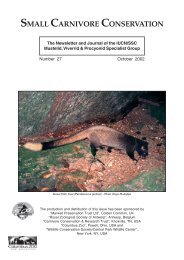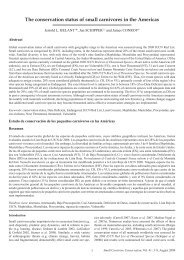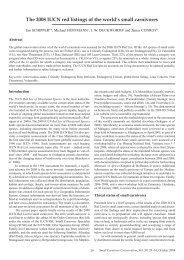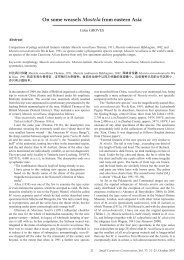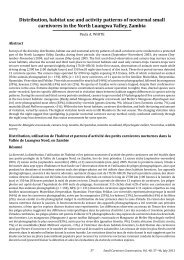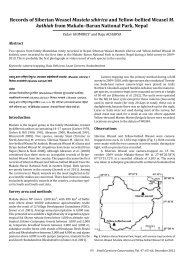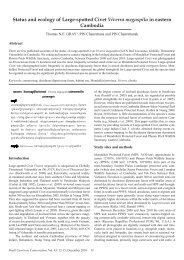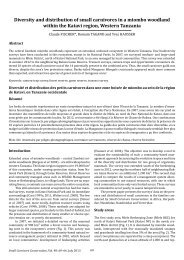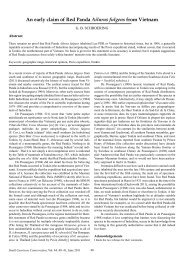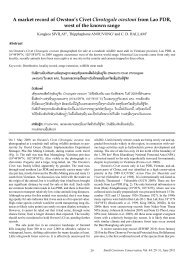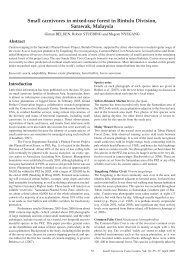First records of Liberian Mongoose - Small Carnivore Conservation
First records of Liberian Mongoose - Small Carnivore Conservation
First records of Liberian Mongoose - Small Carnivore Conservation
You also want an ePaper? Increase the reach of your titles
YUMPU automatically turns print PDFs into web optimized ePapers that Google loves.
<strong>First</strong> <strong>records</strong> <strong>of</strong> <strong>Liberian</strong> <strong>Mongoose</strong> Liberiictis kuhni in<br />
Sapo National Park, southeast Liberia<br />
Tina VOGT 1 , Bernhard Forster 1 , Joshua N. Quawah 2 , Chris Ransom 3 ,<br />
Chloe Hodgkinson 4 and Ben Collen 5<br />
Abstract<br />
<strong>Liberian</strong> <strong>Mongoose</strong> Liberiictus kuhni was photographed three times between November 2011 and February 2012 in two sites<br />
within Sapo National Park, southeast Liberia. These photographs, taken during the day in the early and late afternoon, confirm<br />
its presence 80 km further south than previously recorded in Liberia. Currently listed as Vulnerable by The IUCN Red List <strong>of</strong><br />
Threatened Species, the species was previously only known from northeastern Liberia and western Côte d’Ivoire. Further survey<br />
work is required to establish the limits <strong>of</strong> its distribution.<br />
Keywords: camera-trapping, daytime activity, extension <strong>of</strong> known range<br />
Premières observations de Mangoustes du Libéria Liberiictis kuhni dans le Parc National de Sapo,<br />
au sud-est du Libéria<br />
Résumé<br />
La Mangouste du Libéria Liberiictis kuhni a été photographiée trois fois entre novembre 2011 et février 2012 sur deux sites du<br />
Parc National de Sapo, au sud-est du Libéria. Ces photographies, prises la journée, en début et fin d’après-midi, confirment sa<br />
présence à une distance de 80 km au sud des sites sur lesquels sa présence a été précédemment enregistrée au Libéria. Actuellement<br />
classée «Vulnérable» par la Liste Rouge des Espèces Menacées de l’UICN, l’espèce n’était jusqu’alors connue qu’au nord-est<br />
du Libéria et à l’ouest de la Côte d’Ivoire. Des études complémentaires sont nécessaires pour déterminer les limites de son aire<br />
de répartition.<br />
Mots-clés: piège photographique, extension d’habitat, activité diurne<br />
<strong>Liberian</strong> <strong>Mongoose</strong> Liberiictis kuhni is a poorly documented<br />
small carnivore <strong>of</strong> the area defined by White (1983) as the Upper<br />
Guinean Rainforest. Described in 1958 from eight skulls<br />
found in northeastern Liberia (Hayman 1958), the first complete<br />
specimens were not secured until 1974 (Schlitter 1974)<br />
with the first live specimen captured in Gbi National Forest,<br />
northeastern Liberia in 1989 (Taylor 1992). It has a primarily<br />
dark brown body and a bushy tail, with prominent dark<br />
stripes on the neck, which are bordered by white. Compared<br />
with other mongoose species, <strong>Liberian</strong> <strong>Mongoose</strong> has rather<br />
long claws and an elongated snout with small, reduced cheek<br />
teeth, but long, sharp canines (Schlitter 1974).<br />
Listed as Vulnerable on The IUCN Red List <strong>of</strong> Threatened<br />
Species (IUCN 2012), reliable information on the species’s<br />
population status and distribution range is not available. However,<br />
the population is assumed to be declining: it is hunted<br />
for meat using dogs, shotguns and snares (Taylor 1992,<br />
Greengrass 2011) and extensive habitat loss is occurring in<br />
its range due to logging, mining and conversion to agriculture<br />
(FAO 2011). <strong>Liberian</strong> <strong>Mongoose</strong> occurs in both primary<br />
and secondary forests, and is found mainly in swamp forest<br />
and streambeds with deep sandy soils where earthworms, its<br />
preferred food source, are abundant (Schreiber et al. 1989,<br />
Dunham 2011). Known to turn over large areas <strong>of</strong> the forest<br />
floor while foraging, <strong>Liberian</strong> <strong>Mongoose</strong> is thought to play an<br />
important role as an ‘ecosystem engineer’ by increasing smallscale<br />
ecosystem heterogeneity, affecting seed predation, movement<br />
and germination (Dunham 2011). Recorded in the<br />
wild in northeastern Liberia and Taï National Park, western<br />
Côte d’Ivoire (Goldman & Taylor 1990, Colyn et al. 1998), the<br />
furthest south it has been found previously in Liberia is Nimbowehn,<br />
Gbi National Forest. It was assumed that the species<br />
is very likely to occur in similar suitable habitats in adjacent<br />
areas, including Sapo National Park (= Sapo NP) in southeast<br />
Liberia, approximately 80 km south <strong>of</strong> Gbi. However, previous<br />
attempts to confirm this species’s presence in Sapo NP, by livetraps<br />
and camera-traps, were unsuccessful (Robinson 1983,<br />
Taylor 1992). While a 2010 survey <strong>of</strong> a commercial hunting<br />
camp on the southern border <strong>of</strong> Sapo NP recorded the killing<br />
<strong>of</strong> two individuals, the identity <strong>of</strong> the specimens was unconfirmed<br />
(Greengrass 2011).<br />
Sapo NP, Liberia’s only National Park, comprises an area<br />
<strong>of</strong> 180,365 ha and represents one <strong>of</strong> the most nearly intact<br />
tropical forest ecosystems in Liberia. Contained within one<br />
<strong>of</strong> the largest remaining blocks <strong>of</strong> the threatened Upper Guinean<br />
Forest, Sapo NP consists entirely <strong>of</strong> lowland rainforest,<br />
including swampy areas, dryland and riparian forests. The<br />
terrain throughout the park is generally homogeneous, with<br />
lower (100–200 m) elevations and gently rolling hills in the<br />
southwestern and central parts to higher elevations <strong>of</strong> approximately<br />
400 m in the steeper ridges <strong>of</strong> the northeast. Sapo<br />
NP harbours an exceptional biodiversity with high rates <strong>of</strong> endemism<br />
and provides one <strong>of</strong> the last strongholds for several<br />
globally Endangered species such as Pygmy Hippopotamus<br />
Choeropsis liberiensis, West African Chimpanzee Pan troglodytes<br />
verus and Jentink’s Duiker Cephalophus jentinki.<br />
35 <strong>Small</strong> <strong>Carnivore</strong> <strong>Conservation</strong>, Vol. 47: 35–37, December 2012
Vogt et al.<br />
In 2001, Fauna & Flora International (FFI) in collaboration<br />
with the <strong>Liberian</strong> government’s Forestry Development<br />
Authority (FDA) established a long-term faunal biomonitoring<br />
programme in Sapo NP, which was re-started in 2007 following<br />
the end <strong>of</strong> the civil war (Waitkuwait & Suter 2001, Waitkuwait<br />
2003, Vogt 2011). In 2008, with the support <strong>of</strong> the Zoological<br />
Society <strong>of</strong> London (ZSL), the programme was complemented<br />
by regular systematic camera-trapping surveys (Collen et al.<br />
2011). Surveys were designed to detect wide-ranging and<br />
cryptic species (Collen et al. 2011). Following O’Brien et al.<br />
(2010) a grid <strong>of</strong> 32 infrared heat- and motion- sensitive digital<br />
cameras, spaced at 2 km intervals and mounted 40 cm from<br />
the ground, was set for a minimum <strong>of</strong> 35 days and at 24-hour<br />
operation mode in each <strong>of</strong> two different areas <strong>of</strong> Sapo NP. The<br />
centre <strong>of</strong> each grid square was located using a GPS Garmin map<br />
62s unit, and one camera was secured in an optimal location<br />
(e.g. next to a recently used animal trail), in a 100-m radius<br />
from the centre <strong>of</strong> the grid square. Altitudes were measured<br />
by a GPS Garmin map 62s unit. All positions are given under<br />
the WGS84 datum. No baits or inedible lures were used. One to<br />
three surveys were conducted annually. In the southwestern<br />
part <strong>of</strong> Sapo NP (Survey Grid 1), the camera grid was established<br />
four times, in January–March 2008, May–July 2009, December<br />
2010 – January 2011 and October–November 2011. In<br />
the northern part (Survey Grid 2), the camera grid was established<br />
four times, in November–December 2008, February–<br />
April 2009, June–July 2011 and February–March 2012 (Fig. 1).<br />
<strong>Liberian</strong> <strong>Mongoose</strong> was not recorded before late 2011<br />
despite a prior survey effort <strong>of</strong> 4,500 camera-trap days. Its<br />
first photograph was taken on 8 November 2011 by a camera<br />
in southwestern Sapo NP, at 5°18'45.6"’N, 8°43'32.6"W and<br />
118 m measured altitude (Fig. 2). It was taken at 14h06, in a<br />
swampy area within primary lowland forest. A second record<br />
from the northern part <strong>of</strong> the Park (55 km from the first) was<br />
obtained during February 2012, at 25°29'26.5"N, 8°23'18.1"W<br />
and 202 m measured altitude (Fig. 3). Two series <strong>of</strong> pictures<br />
<strong>of</strong> <strong>Liberian</strong> <strong>Mongoose</strong> were taken by the same camera, on a<br />
gentle slope within primary forest: the first on 8 February at<br />
16h58, the second on 13 February at 14h05. No photograph<br />
showed more than one animal.<br />
Fig. 1. Sapo National Park, Liberia, showing the location <strong>of</strong> the two<br />
camera-trap grids used in 2008–2011.<br />
Fig. 2. The first photograph <strong>of</strong> a <strong>Liberian</strong> <strong>Mongoose</strong> Liberiictis kuhni in<br />
Sapo National Park, Liberia: 8 November 2011. © FFI/FDA/ZSL<br />
Fig. 3. The second record <strong>of</strong> <strong>Liberian</strong> <strong>Mongoose</strong> Liberiictis kuhni in Sapo<br />
National Park, Liberia, in the north: 13 February 2012. © FFI/FDA/ZSL<br />
These first verifiable <strong>records</strong> <strong>of</strong> <strong>Liberian</strong> <strong>Mongoose</strong> in<br />
Sapo NP provide valuable information on the distribution<br />
range <strong>of</strong> this poorly documented species. Explanations for the<br />
comparatively low detection rate and the fact that the animal<br />
was not recorded before the fourth year <strong>of</strong> the ongoing camera<br />
study at present remain speculative and require more investigation.<br />
The survey was not specifically designed for this<br />
species, but to detect medium to large forest-dwelling species.<br />
It further has been found that effective detection distance is<br />
strongly positively related to species body mass and weakly<br />
negatively to species average speed <strong>of</strong> movement (Rowcliffe<br />
et al. 2011). In the context <strong>of</strong> our study it is plausible that, at least<br />
in part, low detection rates are explained by the small body<br />
size <strong>of</strong> L. kuhni. However, comparison with detection rates <strong>of</strong><br />
ground-living mammal species <strong>of</strong> similar or lower size/weight<br />
class at the same time suggest that this is not the case. Table<br />
1 shows the number <strong>of</strong> trap events over the same time period<br />
<strong>of</strong> several species <strong>of</strong> similar or lower weight than <strong>Liberian</strong><br />
<strong>Mongoose</strong>, namely African Brush-tailed Porcupine Atherurus<br />
africanus, two species <strong>of</strong> the large-spotted genet complex (Genetta<br />
bourloni and G. pardina), Marsh <strong>Mongoose</strong> Atilax paludinosus,<br />
Fire-footed Rope Squirrel Funisciurus pyrropus and<br />
Red-legged Sun Squirrel Heliosciurus rufobrachium. Compared<br />
<strong>Small</strong> <strong>Carnivore</strong> <strong>Conservation</strong>, Vol. 47, December 2012<br />
36
<strong>Liberian</strong> <strong>Mongoose</strong> in Sapo NP, Liberia<br />
Table 1. Number <strong>of</strong> trap events <strong>of</strong> selected mammal species similar to or<br />
lighter than <strong>Liberian</strong> <strong>Mongoose</strong> Liberiictus kuhni in weight, during two<br />
camera-trapping surveys in Sapo National Park, Liberia, 2011–2012.<br />
Species 1 Weight (kg) 2 Number <strong>of</strong> trap events 3<br />
November<br />
2011<br />
Atherurus africanus 1.5 – 4.0 111 35<br />
Genetta bourloni 1.2 – 3.1 17 10<br />
Genetta pardina 1.2 – 3.1 10 10<br />
Atilax paludinosus 2.2 – 5.0 39 57<br />
Funisciurus pyrropus 0.16 – 0.30 47 13<br />
Heliosciurus rufobrachium 0.25 – 0.40 6 39<br />
Liberiictis kuhni 2.0 – 2.3 1 2<br />
February<br />
2012<br />
1<br />
English names are given in the text. Species recorded, but heavier than <strong>Liberian</strong><br />
<strong>Mongoose</strong>, are excluded from the table.<br />
2<br />
after Kingdon (1997).<br />
3<br />
Following previous authors (e.g. O‘Brien et al. 2003) each ‘trap-event’ is an independent<br />
photographic event, taken at least 30 minutes apart in cases where the<br />
same social group may be involved in successive pictures.<br />
with capture frequencies <strong>of</strong> these species, <strong>records</strong> <strong>of</strong> <strong>Liberian</strong><br />
<strong>Mongoose</strong> remain few. While this might relate to behavioural<br />
reasons, it might also indicate rarity <strong>of</strong> this species in Sapo NP.<br />
Due to a history <strong>of</strong> illegal settlements <strong>of</strong> armed artisanal<br />
gold miners in the central and southern parts <strong>of</strong> the park, until<br />
recently security restricted monitoring and field research in<br />
Sapo NP to the southwestern and northeastern parts. However,<br />
since the successful evacuation <strong>of</strong> most miners in late 2010,<br />
the biomonitoring programme was consequently extended<br />
over a wider area, and data collection will commence in these<br />
formerly inaccessible parts. It is hoped that the ongoing camera-trap<br />
study will reveal further information on <strong>Liberian</strong><br />
<strong>Mongoose</strong>. Further survey work should also be carried out to<br />
determine the limits <strong>of</strong> its distribution throughout Liberia.<br />
Acknowledgements<br />
The camera-trapping programme is a collaboration project between<br />
Fauna & Flora International, the Forestry Development Authority and<br />
the Zoological Society <strong>of</strong> London, supported by the Fonds Francais Pour<br />
l’Environnement Mondial, the People’s Trust for Endangered Species, the<br />
US Fish and Wildlife Service, Basel Zoo, Aalborg Zoo, Gaia Zoo and BHP<br />
Billiton. We thank the Sapo National Park staff, especially the biomonitoring<br />
teams, for their great work and support in the field. We would<br />
also like to thank our referees, Philip Robinson, Mark Taylor and Amy<br />
Dunham, and Aude Desmoulins, who provided the French translation.<br />
References<br />
Collen, B., Howard, R., Konie, J., Daniel, O. & Rist, J. 2011. Field surveys<br />
for the endangered Pygmy Hippopotamus Choeropsis liberiensis<br />
in Sapo National Park, Liberia. Oryx 45: 35–37.<br />
Colyn, M., Barriere, P., Formenty, P., Perpete, O. & Van Rompaey, H.<br />
1998. <strong>First</strong> confirmation <strong>of</strong> the presence <strong>of</strong> the <strong>Liberian</strong> <strong>Mongoose</strong>,<br />
Liberiictis kuhni, in Côte d’Ivoire. <strong>Small</strong> <strong>Carnivore</strong> <strong>Conservation</strong><br />
18: 12–14.<br />
Dunham, A. E. 2011. Soil disturbance by vertebrates alters seed predation,<br />
movement and germination in an African rainforest.<br />
Journal <strong>of</strong> Tropical Ecology 27: 581–589.<br />
[FAO] Food and Agriculture Organisation <strong>of</strong> the United Nations 2011.<br />
The state <strong>of</strong> the world’s forests 2011. FAO, Rome, Italy.<br />
Goldman, C. A. & Taylor, M. E. 1990. Liberiictis kuhni. Mammalian Species<br />
348: 1–3.<br />
Greengrass, E. 2011. Exploring the dynamics <strong>of</strong> bushmeat hunting and<br />
trade in Sapo National Park. Fauna & Flora International, Cambridge,<br />
U.K.<br />
Hayman, R. W. 1958. A new genus and species <strong>of</strong> West African mongoose.<br />
Annals and Magazine <strong>of</strong> Natural History (13)1: 448–452.<br />
IUCN 2012. IUCN Red List <strong>of</strong> Threatened Species. Version 2012.1.<br />
. Downloaded on 21 August 2012.<br />
Kingdon, J. 1997. The Kingdon field guide to African mammals. A & C<br />
Black, London, U.K.<br />
O’Brien, T. G., Kinnaird, M. F. & Wibisono, H. T. 2003. Crouching Tigers,<br />
hidden prey: Sumatran Tiger and prey populations in a tropical<br />
forest landscape. Animal <strong>Conservation</strong> 6: 131–139.<br />
O’Brien, T. G., Baillie, J. E. M., Krueger, L. & Cuke, M. 2010. The Wildlife<br />
Picture Index: monitoring top trophic levels. Animal <strong>Conservation</strong><br />
13: 335–343.<br />
Robinson, P. T. 1983. The proposed Sarpo National Park in Liberia: a<br />
field study <strong>of</strong> prospects and problems. National Geographic Society<br />
Research Reports 21: 425–435.<br />
Rowcliffe, J. M., Carbone, C., Jansen, P. A., Kays, R. & Kranstauber, B. 2011.<br />
Quantifying the sensitivity <strong>of</strong> camera traps: an adapted distance<br />
sampling approach. Methods in Ecology and Evolution 2: 464–476.<br />
Schlitter, D. A. 1974. Notes on the <strong>Liberian</strong> <strong>Mongoose</strong>, Liberiictis kuhni<br />
Hayman, 1958. Journal <strong>of</strong> Mammalogy 55: 438–442.<br />
Schreiber, A., Wirth, R., Riffel, M. & Van Rompaey, H. 1989. Weasels,<br />
civets, mongooses, and their relatives. An action plan for the conservation<br />
<strong>of</strong> mustelids and viverrids. IUCN, Gland, Switzerland.<br />
Taylor, M. E. 1992. The <strong>Liberian</strong> <strong>Mongoose</strong>. Oryx 26: 103–106.<br />
Vogt, M. 2011. Biomonitoring & research programme, Sapo National<br />
Park: results <strong>of</strong> Sapo National Park bio-monitoring programme<br />
2007–2009. Fauna & Flora International, Cambridge, U.K.<br />
Waitkuwait, W. E. 2003. Report on the first year <strong>of</strong> operation <strong>of</strong> a community-based<br />
bio-monitoring programme in and around Sapo<br />
National Park, Sinoe County, Liberia. Fauna & Flora International,<br />
Cambridge, U.K.<br />
Waitkuwait, W. E. & Suter, J. 2001. Report on the establishment <strong>of</strong> a<br />
community-based bio-monitoring programme in and around<br />
Sapo National Park, Sinoe County, Liberia. Fauna & Flora International,<br />
Cambridge, U.K.<br />
White, F. 1983. The vegetation <strong>of</strong> Africa: a descriptive memoir to accompany<br />
the UNESCO/AETFAT/UNSO vegetation map <strong>of</strong> Africa.<br />
UNESCO, Paris, France.<br />
1<br />
Fauna & Flora International Liberia, Henry Andrews<br />
Building, Tubman Blvd, Congo Town, Monrovia, Liberia.<br />
Email: martina.vogt@fauna-flora.org<br />
2<br />
Forestry Development Authority, Whein Town,<br />
Paynesville, Monrovia, Liberia.<br />
3<br />
<strong>Conservation</strong> Programmes, Zoological Society <strong>of</strong><br />
London, Regent’s Park, London NW1 4RY, U.K.<br />
4<br />
Fauna & Flora International, 4th Floor, Jupiter House,<br />
Station Road, Cambridge, U.K.<br />
Email: chloe.hodgkinson@fauna-flora.org<br />
5<br />
Institute <strong>of</strong> Zoology, Zoological Society <strong>of</strong> London,<br />
Regent’s Park, London NW1 4RY, U.K.<br />
37 <strong>Small</strong> <strong>Carnivore</strong> <strong>Conservation</strong>, Vol. 47, December 2012



